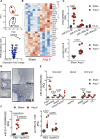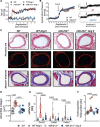T-Cell-Derived miRNA-214 Mediates Perivascular Fibrosis in Hypertension
- PMID: 32065054
- PMCID: PMC7147427
- DOI: 10.1161/CIRCRESAHA.119.315428
T-Cell-Derived miRNA-214 Mediates Perivascular Fibrosis in Hypertension
Abstract
Rationale: Despite increasing understanding of the prognostic importance of vascular stiffening linked to perivascular fibrosis in hypertension, the molecular and cellular regulation of this process is poorly understood.
Objectives: To study the functional role of microRNA-214 (miR-214) in the induction of perivascular fibrosis and endothelial dysfunction driving vascular stiffening.
Methods and results: Out of 381 miRs screened in the perivascular tissues in response to Ang II (angiotensin II)-mediated hypertension, miR-214 showed the highest induction (8-fold, P=0.0001). MiR-214 induction was pronounced in perivascular and circulating T cells, but not in perivascular adipose tissue adipocytes. Global deletion of miR-214-/- prevented Ang II-induced periaortic fibrosis, Col1a1, Col3a1, Col5a1, and Tgfb1 expression, hydroxyproline accumulation, and vascular stiffening, without difference in blood pressure. Mechanistic studies revealed that miR-214-/- mice were protected against endothelial dysfunction, oxidative stress, and increased Nox2, all of which were induced by Ang II in WT mice. Ang II-induced recruitment of T cells into perivascular adipose tissue was abolished in miR-214-/- mice. Adoptive transfer of miR-214-/- T cells into RAG1-/- mice resulted in reduced perivascular fibrosis compared with the effect of WT T cells. Ang II induced hypertension caused significant change in the expression of 1380 T cell genes in WT, but only 51 in miR-214-/-. T cell activation, proliferation and chemotaxis pathways were differentially affected. MiR-214-/- prevented Ang II-induction of profibrotic T cell cytokines (IL-17, TNF-α, IL-9, and IFN-γ) and chemokine receptors (CCR1, CCR2, CCR4, CCR5, CCR6, and CXCR3). This manifested in reduced in vitro and in vivo T cell chemotaxis resulting in attenuation of profibrotic perivascular inflammation. Translationally, we show that miR-214 is increased in plasma of patients with hypertension and is directly correlated to pulse wave velocity as a measure of vascular stiffness.
Conclusions: T-cell-derived miR-214 controls pathological perivascular fibrosis in hypertension mediated by T cell recruitment and local profibrotic cytokine release.
Keywords: blood pressure; collagen; fibrosis; hypertension; inflammation.
Figures








Comment in
-
A T-Cell Small RNA With miRacle Effects on Aortic Stiffening.Circ Res. 2020 Apr 10;126(8):1004-1006. doi: 10.1161/CIRCRESAHA.120.316845. Epub 2020 Apr 9. Circ Res. 2020. PMID: 32271686 Free PMC article. No abstract available.
References
-
- Collaborators GBDRF. Global, regional, and national comparative risk assessment of 79 behavioural, environmental and occupational, and metabolic risks or clusters of risks, 1990-2015: a systematic analysis for the global burden of disease study 2015. Lancet. 2016;388:1659–1724. 10.1016/S0140-6736(16)31679-8. - PMC - PubMed
-
- Nilsson PM, Boutouyrie P, Laurent S. Vascular aging: a tale of EVA and ADAM in cardiovascular risk assessment and prevention. Hypertension. 2009;54:3–10. 10.1161/HYPERTENSIONAHA.109.129114. - PubMed
-
- Guzik TJ, Touyz RM. Oxidative stress, inflammation, and vascular aging in hypertension. Hypertension. 2017;70:660–667. 10.1161/HYPERTENSIONAHA.117.07802. - PubMed
Publication types
MeSH terms
Substances
Grants and funding
LinkOut - more resources
Full Text Sources
Medical
Molecular Biology Databases
Miscellaneous

